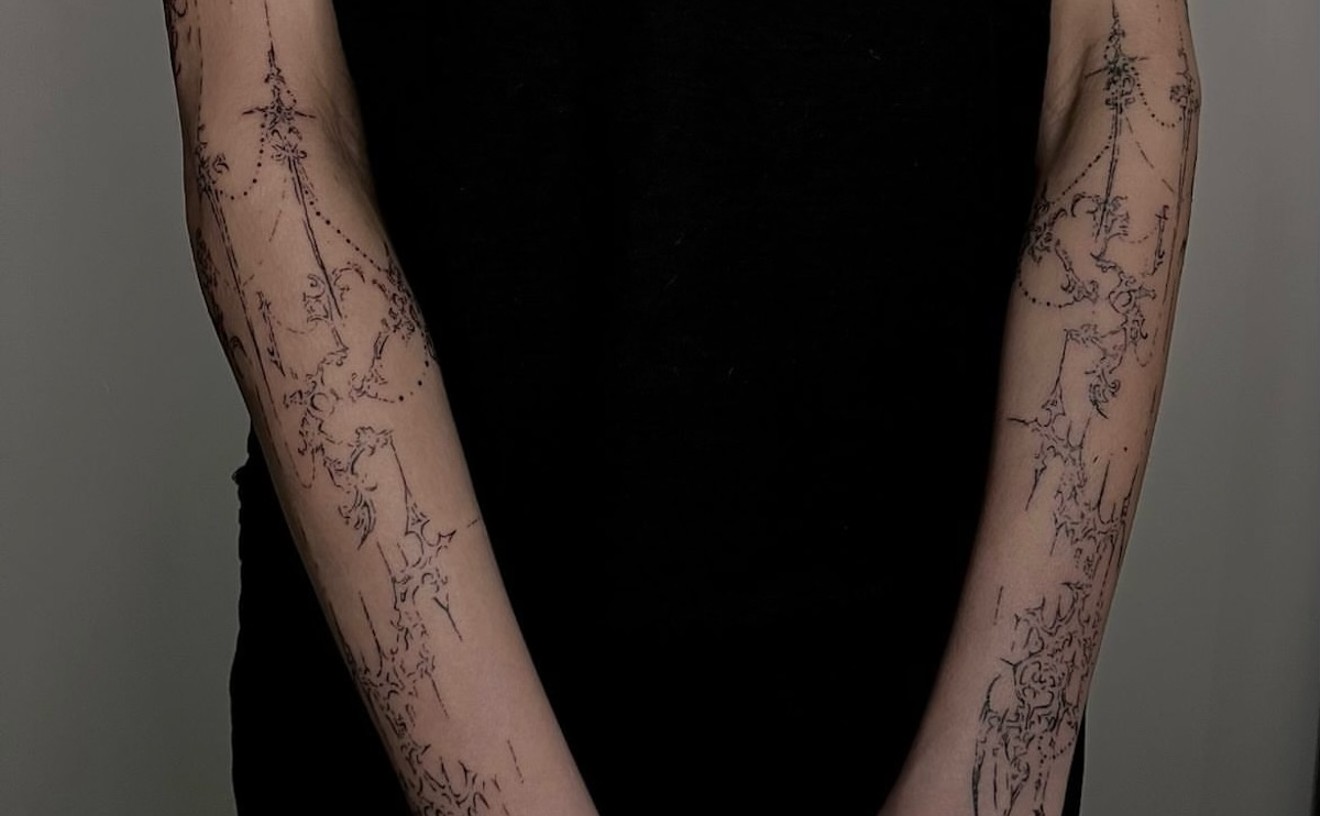A blue thicket of braided, industrial nylon rope winds through the four-story atrium gallery at the Institute of Contemporary Art (ICA Miami) in the Design District. A foot wide at one end, the rope narrows and wraps around the museum's white support beams and columns like a giant cobra. By the time it reaches the first floor, the rope is but the width of an index finger. It disappears in a back corner into a dress that covers a pair of women's legs protruding from a semicircular hole in the wall.
In Brazilian artist Laura Lima's exhibition "The
After responding to a casting call, 24-year-old Kayla Delacerda and another young woman, who asked not to be named, say they were instructed to vaginally penetrate themselves with the end of the blue nylon rope. Because penetration was not explicit in the $15-per-hour job description, both say they were disturbed to hear about a bowl of finger condoms and lube in the staging area. Delacerda says she was misled and refused to participate. But the other young woman says on the June 3 opening night, she violated herself under the museum and artist's direction and has been suffering emotionally since.
"I thought it would be an honor to participate in the exhibit with the ICA and that I'd be OK," the young woman says. "But it doesn't matter how credible a place or person is; as a woman, you're always susceptible to this kind of danger."
Lima, the artist, responds that she never pressured anyone, nor did she ask models to do anything that made then uncomfortable. She held group and one-on-one sessions to explain her vision. "Given the clear and open discussion we had, which I see as being a fundamental dimension of the final work itself, I was surprised to hear of this complaint," Lima said in a statement. "[The anonymous woman who complained] was very enthusiastic and, in her words, 'committed to the piece.' "
ICA Miami's director, Ellen Salpeter, also denies the museum pressured performers to insert the rope. Participants only had to wear a dress made by Lima and inhabit the room for four hours. They were paid $15 per hour. Salpeter says in a statement to New Times that the ICA has not received any other complaints from contracted performers and that condoms intended to cover the end of the rope were made available only "in case the performers elect to use them... Laura's work empowers the performer to make decisions about how they will participate. The museum and the artist explicitly told performers that their privacy and comfort is paramount and that they should not under any circumstance do anything they do not wish to do."
"The museum and the artist explicitly told performers that their privacy and comfort is paramount."
tweet this
Delacerda, a graduate of the vaunted Design and Architecture Senior High and an artist who has participated in other performance pieces, scoffs. "If it were up to Laura Lima, all six of us would be having sex with the same piece of rope. How is that feminist or empowering?"
Lima's work has roots in the oeuvre of other female performance artists. In the early 1970s, Brazil's Lygia Clark lay face-down and had participants stuff colored yarn into their mouths and then spit it on her. In 1974, Serbian artist Marina Abramovic placed 72 items, from feathers and olive oil to a knife and a loaded gun, at a gallery. She welcomed participants to do whatever they wanted. Some cut Abramovic's hair, others took the knife to her skin, and one man put the gun to her head. In 1975, American artist Carolee Schneemann stood naked in a museum gallery, pulled a scroll of paper from her vagina, and read aloud the poetry written on it.
"What's interesting about Laura Lima is that it's the artist orchestrating the intervention on someone else's body as opposed to her own body," says Nathan Timpano, an art historian at the University of Miami. "The larger question is why did Laura Lima choose not to perform the piece herself?"
Even Serbia's famous artist Abramovic has faced controversy for hiring participants for her performance pieces. In 2013, she brought in six women for one of her works. They lay naked with skeletons on top of them as the centerpiece of a table at the Museum of Contemporary Art Los Angeles' annual gala. One of the young women at first agreed but then dropped out and criticized Abramovic for the lousy pay ($150) and working conditions.
"But that was more about forming an artists' union than sexual harassment," Timpano explains. "What's really interesting about this situation is that it is female-to-female, where historically it tends to be male hegemony over women."
Born in southwest Brazil, Lima studied at the School of Visual Arts of Parque Lage in Rio de Janeiro. In 2003, she and two other artists founded a small contemporary gallery called A Gentil Carioca in Rio's financial center. Since then, Lima has held solo exhibitions worldwide, from Madrid to Switzerland, the Netherlands, Argentina, and New York. In 2014, Lima was awarded the Bonnefanten Award for Contemporary Art, the most prestigious international award for visual art in the Netherlands.
Lima, often using naked participants in provocative ways, sometimes shocks her audiences. In a 1997 exhibit, a woman ingested a sleeping pill and passed out under crocheted fabric. In 2010, a naked man and woman were suspended in a hammock with hair extensions trailing from the man's eyebrows to his lap and hair extensions from the woman's pubic hair cascading onto the floor. In 2013, a naked man struggled helplessly with black ropes attached like backpack straps to his shoulders and a museum's column.
"When I invite people to participate in my pieces, it is not a casting call for a
In the past, Lima has said she does not choreograph movements for participants or hold rehearsals, but instead creates "performative situations."
ICA Miami is a natural location for such a cutting-edge artist. Since its inception in 2014, the museum has been praised for attracting the work of emerging and well-established artists. Following
The casting call for Lima's exhibit, "The Inverse," went out in mid-May. It explained participants would be paid $15 an hour for four-hour shifts. There is no mention of vaginas, penetration, or even finger condoms in the description. The "
In a statement to participants, Lima wrote, "The legs are folded and slightly open in a comfortable pose... the coupling between the rope and the participant will be made directly by the participant." At the end, she added, "I daresay that this is probably one of the most important works in my career, and I'm thrilled that [ICA curator] Alex Gartenfeld and the ICA have made it possible."
Based on that description, Delacerda thought the work would be a simple way to make money. On May 25, she attended a group meeting about the exhibit, along with five other participants, Lima, Gartenfeld, and exhibition manager Kerri Kneer.
It seemed to Delacerda that the museum's only concern was about participants lying down for such a long period of time. But at the meeting, Lima mentioned a bowl of finger condoms and lube. Then, Delacerda says, she realized she would be expected to insert the end of the rope inside herself.
"[Lima] did this nonsensical demonstration of the rope touching the vagina using her forearm," Delacerda recalls. "She was like, 'It must at least touch the vagina,' and she put the rope to her forearm."
The idea of such intimate contact made Delacerda uneasy, but she didn't speak up at the meeting. She even turned in a signed contract to the exhibition manager before leaving. But she couldn't stop thinking about Lima. She felt misled because the renderings she had seen before attending the meeting hadn't depicted the rope. It seemed both exploitative and unreasonable for the $15-per-hour paycheck. She also had concerns that she hadn't seen any security guards, simply a sign propped beside the women's legs that read, "Please respect the safety and privacy of artwork participant."
Four days after the May 25 meeting, in response to a note from exhibition manager Kneer, Delacerda sent a strongly worded email explaining she would not participate: "I think it's really messed up that the artist wants to hire people at $15 an hour to lie down with a piece of rope penetrating women's bodies sexually... I do not recommend anyone to take my place because I don't want anyone I know to be in that position."
On May 31, Kneer replied, "I'm sorry you feel that way. Thank you for your time and input."
To take Delacerda's place, another female participant recommended the job to a woman whom we'll call Alice (she asked that her real name
Alice says she was invited to the museum June 2, a day before opening night. She says Kneer assured her she would not have to do anything that made her uncomfortable.
On opening night, Alice says, she arrived at the ICA a little before the 7 p.m. reception. Though she had not expected to perform at that time, she soon learned a woman who had been scheduled was late — delayed by rush-hour traffic.
Kneer told her she would have to take that participant's place. In a private room, Alice says, Lima placed a condom on the end of the rope and handed it to her. Then Lima went to look for lube. "I was alone with the artist and felt cornered," the young woman says. "I would do anything for art and for art's sake, but I didn't expect what happened to have actually happened."
The young woman says Lima then explained that inserting the rope into her vagina was critical to the piece. "Are you wearing any underwear?" Alice says Lima asked. "No," Alice responded. "Perfect," the artist replied.
Alice then put on the white dress and lay down. She grasped the rope with the condom on the end and added some lube. Then she inserted it and pushed her feet through the semicircular hole into the exhibit. Alice says Lima adjusted her legs and said, "Good. Now everyone can see you."
Alice says she instantly regretted it. She was in pain. She says she lay there for hours in horror as visitors poked her, asking if she was real. "I was panicking, terrified," she says. "When it happened, I was so vulnerable and going through a lot emotionally."
Neither Lima nor Salpeter responded to an inquiry from New Times about how many women had inserted the rope. In a written statement, Salpeter says, "There are no obligations in the work beyond inhabiting the room and [wearing] a dress designed by the artist." Salpeter adds that performers were "encouraged to bring anything they needed to make them feel comfortable."
Lima, in her statement, called the performance "absolutely voluntary... at any
But for Alice, the shift on opening night was a nightmare. "I cried for hours in that room, and I had to lie to my friend who saw me and say it was from heartache," she says. "I felt inhuman and so defenseless."
Adds Delacerda: "They treated us like an art object and not a person. It's like sex; if you're down for being choked, that's fine, but if you're not, you [shouldn't] force someone to."
The exhibit is scheduled to run through October 30. A rotating schedule of young women












